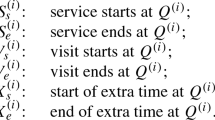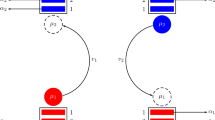Abstract
This paper analyzes the polling system in which, unlike nearly all previous studies, the server comes to a stop when the system is empty rather than continuing to cycle. The possibility of server stopping permits a rich variety of alternatives for server behavior; we consider threestopping rules, governing server behavior when the system is emptied, and twostarting rules, governing server behavior when an arrival occurs to an idle system. The Laplace-Stieltjes Transforms and means for the waiting time andserver return time (the interval from an arrival at an unserved queue until the server returns to that queue) are determined. For the special case of zero changeover times and strictly cyclic service, explicit results are obtained.
Similar content being viewed by others
References
J.E. Baker and I. Rubin, Polling with a general-service order table, IEEE Trans. Commun. COM-35 (1987) 283–288.
J.P.C. Blanc and R.D. van der Mei, The power-series algorithm applied to polling systems with a dormant server, No. 9346, Discussion Paper Series, CentER, Tilburg University, The Netherlands (1993).
S.C. Borst, A polling system with a dormant server, Report BS-R9313, Centrum voor Wiskunde en Informatica, part of Stichting Mathematisch Centrum, The Netherlands (1993).
P.J. Burke, Delays in single-server queues with batched input, Oper. Res. 23 (1975) 830–833.
G.L. Choudhury, Polling with a general service order table: gated service, in:Proc. IEEE INFOCOM '90, San Francisco (1990) pp. 268–276.
R.B. Cooper, Queues served in cyclic order: waiting times, Bell Syst. Techn. J. 49 (1970) 399–413.
R.B. Cooper and G. Murray, Queues served in cyclic order, Bell Syst. Techn. J. 48 (1969) 675–689.
R.B. Cooper, S.-C. Niu and M.M. Srinivasan, A decomposition theorem for polling models: the switchover times are effectively additive, Oper. Res. (1993), to appear.
M. Eisenberg, Two queues with changeover time, Oper. Res. 19 (1971) 386–401.
M. Eisenberg, Queues with periodic service and changeover time, Oper. Res. 20 (1972) 440–451.
M.J. Ferguson and Y.J. Aminetzah, Exact results for nonsymmetric token ring systems, IEEE Trans. Commun. COM-33 (1985) 223–231.
S.W. Fuhrmann, A decomposition result for a class of polling models. Queueing Syst. 11 (1992) 109–120.
O. Hashida, Analysis of multiqueue, Rev. Elect. Commun. Labs. 20 (1972) 189–199.
A.G. Konheim, H. Levy and M.M. Srinivasan, Descendant set: an efficient approach for the analysis of polling systems, IEEE Trans. Commun. (1992), to appear.
H. Levy and L. Kleinrock, Polling systems with zero switch-over periods: a general method for analyzing the expected delay, Perf. Eval. 13 (1991) 97–107.
J.A.C. Resing, Polling systems and multitype branching processes, Queueing Syst. 13 (1993) 409–426.
D. Sarkar and W.I. Zangwill, Expected waiting time for nonsymmetric cyclic queueing systems — exact results, Manag. Sci. 35 (1989) 1463–1474.
M.M. Srinivasan and D. Gupta, When should a roving server be patient? (1993), to appear.
M.M. Srinivasan, H. Levy and A.G. Konheim, The individual station technique for the analysis of polling systems (1993), to appear.
H. Takagi, Queueing analysis of polling models: an update, in:Stochastic Analysis of Computer and Communications Systems (Elsevier Science/North-Holland, 1990) pp. 267–318.
Author information
Authors and Affiliations
Rights and permissions
About this article
Cite this article
Eisenberg, M. The polling system with a stopping server. Queueing Syst 18, 387–431 (1994). https://doi.org/10.1007/BF01158769
Received:
Revised:
Issue Date:
DOI: https://doi.org/10.1007/BF01158769




